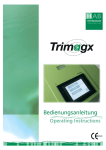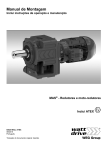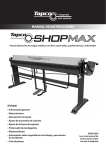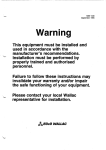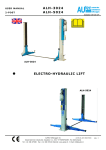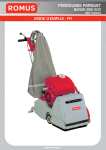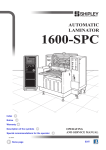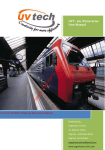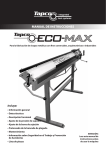Download Operating instructions ECA ECB ECC ECE ECG ECH ECI
Transcript
ENEMAC Operating instructions Safety couplings types ECA ECB (ECC) mode of function When the machine is operating normally the steel balls are pressed by the disk spring into the cupped recesses located in the flange ring, thereby transmitting the torque from the hub to the flange ring and vice-versa. switching distance bearing for belt pulley ECA overload In the event of overloading the hub turns round in relation to the flange ring and presses the balls out of the recesses back against the disk spring - the coupling clicks over - (once per revolution in case of fixed point switching) and actuates the proximity switch, which has to shut off the drive immediately. The coupling is only designed to click over for a short period ! proximity switch steel balls h2 hub bushing engage After elimination of the disturbance, the coupling has to be rotated - with low rotational speed or by hand and reengages automatically (audible) in the fixed point position. The coupling now is operational, the adjusted disengagement torque is effective. flange ring adjustment nut h1 disk spring ECB switch plate technical data ECA 1 3 6 16 25 40 63 75 100 130 250 400 ECB + ECC 3 6 16 25 40 63 100 250 400 torque range (adjustable) 0,9 3 6 16 25 45 75 75 130 130 250 400 TA max (Nm) TA min (Nm) 0,5 1,2 2,5 6 10 20 30 30 50 50 100 160 –1 max. rotational speed (min ) 3000 3000 3000 3000 3000 3000 2500 2500 2500 2500 2000 2000 thread of screws h 2 6x M3 M4 M4 M4 M5 M5 M6 M6 M6 M6 M8 M8 torque of hub screws h 2 (Nm) 1 1,5 1,5 2,5 3 4 6 6 8 8 35 35 thread of flange ring h 1 6x M3 M4 M4 M4 M6 M6 M6 M6 M6 M6 M8 M8 max. screw position i (mm) 6 8 8 10 12 12 12 12 12 12 16 16 metal bellows data type ECC (type ECC is no longer available) max. shaft misalignment lateral (mm) 0,27 0,27 0,2 0,2 0,2 0,2 0,2 0,2 0,2 0,8 0,8 0,8 0,9 0,9 1,3 1,2 1,2 1,0 axial ± (mm) 3 torsion resistance (10 Nm/Rad) 5 5 21 33 33 54 66 108 164 lateral spring rate (N/mm) 29 29 189 262 262 218 401 503 692 The torque data are valid for the tightening screws h 2 of the bushing only. The screws h 1 for the pulley must be tightened with the usual torque ! Please take notice of the max. screw position i (into the flange ring) installation instructions general remarks 1. The kind of fit between bushing and shaft must be a sliding fit (e. g. H7/j6 or G7/k6). The frictional connection will not be impaired by existing keyways. 2. During delivery the screws of the bushing are slightly tightened. To enable the hub slipping on the shaft, the bushing and it’s screws have to been loosened. 3. The screws must be tightened cross-wise to avoid axial run-out of the coupling. Especially with type ECB a severe wobble will cause tilting of the pulley and seizing up on the shaft end. In case of collision the pulley cannot rotate and the coupling cannot disengage. Tightening torque of screws see Technical data. 4. dismounting After unscrewing the 6 tightening screws the bushing is released from the hub by means of 3 draw-off screws (see illustration to the right). If axial space is restrictive it is advisable to screw in the draw-off screws before mounting the coupling and to counter check them against the hub. 5. emergency switching In case of overload the drive must be turned off immediately by means of an emergency switching. A proximity switch can be activated by the axial motion of the switch plate of the coupling and initiate the machine stop. All couplings are designed for 250 overload cycles. 6. mounting in vertical axes of CNC machine tools It must be taken in consideration that after disengagement the EC-coupling has a residuel torque so low that in most of cases it is insufficient to prevent the descenting of the machine axle. for safety couplings type ECA 7. The axial center lines of the belt pulley and the ball bearing of type ECA should be in alignment, to prop the traction of the belt directly by the bearing (see illustration to the right). 8. The kind of fit between pulley and bearing must be a sliding fit (H7/h5). Dimension k 2 must be machined within 0 trough +0.1 mm. The stop collar at left of the outer race of the bearing must at least have 3 mm to guarantee the plane rest of both parts (see illustration to the right). for safety couplings type ECB 9. A pulley to be attached to type ECB must have a complete plane surface on the side of the coupling. As well the ECB as the pulley are separately centered to the shaft thus an additional centering between both is in no way tolerable. ENEMAC Operating instructions Safety couplings types ECA ECB (ECC) for safety couplings type ECC (type ECC is no longer available) 10. ATTENTION! The metal bellows of the ECC’s are made of thin stainless steel thus beeing susceptible to shocks. Damage to bellows can result in an unserviceable coupling ! 11. The ECC can compensate for shaft misalignments within certain limits (= max. lateral shaft misalignment see Technical data). ECC It must be acted upon the following instructions to obtain the actual lateral shaft misalignment: The set-up of the dial gauge is shown by the picture, i. e. fastening of the gauge to one side (shaft 2) of the already mounted coupling and zero adjustment of the caliper. A 360° turn of the complete measuring system and observation of the maximum reading. The lateral shaft misalignment is half of this reading. shaft 1 shaft 2 In case of a set-up without a mounted ECC the dial gauge has to fastened to shaft 2 and the caliper adjusted to shaft 1. Turning shaft 2 by 360° the maximum reading will include the amount of defect of form (=out of round), but this deviation can be neglected in nearly all cases. The complete 360° turn of the measuring system is essential ! 12. Mounting of the ECC-coupling The first step is to position the coupling loose on both shaft ends and then to tighten it to shaft 2. Possible axial tension of the bellows must be released by turning one shaft end while stopping the other one. The bushing of shaft 1 may not be tightened before completing this tension release. During mounting the bellows shall not be deformed too much. Permitted are 0.6 mm lateral and ± 1 mm axial. Under operation conditions however the values of Technical data are valid. adjustment of disengagement torque TA operating range characteristic curve of disk spring The disengement torque TA is continuously adjustable (without change the disk spring) ! Special torque ranges on request. The couplings are pre-set by the manufacturer on assembly at about 70% of the maximum torque. setting range switching distance MAX The torque can be subsequently adjusted by turning the adjustment nut with a sickle spanner. Loosen the Allen set screws beforehand ! Opposite to the common practice this results in the effect, that turning the adjustment nut clockwise counter-clockwise ⇒ ⇒ TA decreases TA increases torque TA IMPORTANT ! The characteristic curve of the disk spring is diminishing within the setting range ! MIN spring distance (see illustration to the right and foot) released plan surface The really effective TA can only be measured precise, if ♦ ♦ ♦ coupling and belt-pulley or intermediate flange are assembled or the measuring device simulates this assembly and points 7 trough 9 of the Installation instructions are taken into consideration arrangement of disk spring range of adjustment adjustment nut conical hub Allen set screw marking ENEMAC GmbH The marking on the hub (see illustration to the left) must be between MIN and MAX in the adjustment range (=greater part of the circumference of the adjustment nut). By no means adjust torque below MIN, because in that case the disk spring will be blocked during disengagement, and the coupling will not operate. After adjustment the nut has to be fixed against turning by means of the Allen set srews (fixed with LOCTITE 222 or similar). 63839 Kleinwallstadt Daimler Ring 42 Germany « +49 (0) 6022 7107-0 [email protected] ¬ +49 (0) 6022 22237 enemac.de KW 10/12 ENEMAC Operating instructions Torque Limiters types ECE ECG ECH ECI ECR mode of function switching distance When the machine is operating normally the steel balls are pressed by the disk spring into the cupped recesses located in the flange ring, thereby transmitting the torque from the hub to the flange ring and vice-versa. proximity switch ECE flange ring overload h In the event of overloading the hub turns round in relation to the flange ring and presses the balls out of the recesses back against the disk spring - the clutch clicks over - (once per revolution in case of fixed point switching) and actuates the proximity switch, which has to shut off the drive immediately. The clutch is only designed to click over for a short period ! threaded pin as axial fixation in „L“ version hub engage adjustment nut After elimination of the disturbance, the clutch has to be rotated - with low rotational speed or by hand and reengages automatically (audible) in the fixed point position. The clutch now is operational, the adjusted disengagement torque is effective. seat for sliding bearing disk spring steel balls ECG/ECI technical data ECE ECG ECI torque range (adjustable) TA max TA min max. rotational speed thread of flange ring h max. screw position i ECR (stainless steel) torque range (adjustable) TA max TA min max. rotational speed thread of flange ring h max. screw position i 5 5 (Nm) (Nm) -1 (min ) 6x (mm) 16 16 25 25 40 40 63 63 100 100 200 200 315 630 315 630 900 900 5 10 16 25 40 63 100 200 315 315 630 630 900 2 4 7 10 16 25 40 80 140 140 280 280 400 3000 3000 3000 3000 3000 3000 2500 2500 1800 1800 1800 1800 1800 M5 M5 M6 M6 M6 M6 M6 M6 M8 M10 M8 M10 M10 6 6 8 8 8 8 12 12 15 15 15 15 15 50 (Nm) (Nm) -1 (min ) 6x (mm) 10 10 100 160 240 h 50 100 160 240 15 40 60 100 3000 3000 2500 2500 M6 M6 M8 M8 8 8 12 12 ECR The screws h for the drive element must be tightened with the usual torque ! Please take notice of the max. screw position i (into the flange ring). ECH (chain wheel integrated) torque range (adjustable) TA max (Nm) TA min (Nm) -1 max. rotational speed (min ) 5 16 25 40 63 80 140 200 400 630 900 5 16 25 40 63 80 140 200 400 630 900 2 6 10 16 25 32 56 80 160 280 400 3000 3000 3000 2800 2800 2500 2500 2000 2000 1500 1500 ECH installation instructions general remarks 1. The fit between the hub and shaft should be chosen as close sliding fit (e. g. H7/j6 or G7/k6). Keyway according to DIN 6885 sheet 1. 2. For axial fixation (against displacement on the shaft) threaded pins are provided that clamp the hubs against the keyways. An exception is the version „K“ in the types ECE/ECG and ECI, which are for example fixed by a stop collar and washer. 3. The maximum rotational speeds specified in the Technical data refer only to the respective clutch by itself. If drive elements are incorporated that permit lower rotational speeds, these are obviously decisive, (e. g. the maximum permissible chain speed). 4. Emergency switching In order to protect the machine and clutch, the drive must be shut off in the event of overloading ! Normally the disk spring of the clutch activates, via the switching distance, a proximity switch arranged in axial direction and which disconnects the motor power circuit. for types ECE, ECG, ECI and ECR: 5. The drive element (e. g. pulley) is simply bolted onto the clutch, the torque being transmitted by friction. 6. ECE and pulley are both centred on the shaft and must not be additionally centred relative to one another by a fit bearing. 7. With type ECE the drive element (e. g. pulley) must have its own sliding bearing on the shaft, which supports the tractive force of the belt. The clutch cannot absorb this force. 8. Points 6 and 7 apply as appropriate to types ECG, ECI and ECR. In this case the drive element is centred and mounted directly on the clutch bearing instead of on the shaft. In order to have a lower sliding speed in the event of overloading, the sliding bearing is incorporated in the drive element (is therefore not included in the delivery specification of the ECG, ECI or ECR). 9. The slide bearing clearance has to be < 0,03 mm. For the types ECG, ECI and ECR we recommend the installation of the slide bearing SKF type GLYCODUR F. The tolerance f 7 of the bearing is matched to these slide bearings. 10. With type ECE an adapter flange enables also small pulleys or chain wheels to be installed. ENEMAC Operating instructions Torque Limiters types ECE ECG ECH ECI ECR adjustment of disengagement torque TA operating range The disengagement torque TA is continuously adjustable (without change the disk spring) ! characteristic curve of disk spring Special torque ranges on request. The couplings are pre-set by the manufacturer on assembly at about 70% of the maximum torque. setting range switching distance MAX The torque can be subsequently adjusted by turning the adjustment nut with a sickle spanner. Loosen the Allen set screws beforehand ! Opposite to the common practice this results in the effect, that turning the adjustment nut ... clockwise counter-clockwise ⇒ ⇒ TA decreases TA increases torque TA IMPORTANT ! The characteristic curve of the disk spring is diminishing within the setting range ! MIN spring distance (see illustration to the right and foot) released plan surface range of adjustment arrangement of disk spring adjustment nut hub Allen set screws marking ENEMAC GmbH The marking on the hub (see illustration to the left) must be between MIN and MAX in the adjustment range (=greater part of the circumference of the adjustment nut). By no means adjust torque below MIN, because in that case the disk spring will be blocked during disengagement, and the coupling will not operate. After adjustment the nut has to be fixed against turning by means of the Allen set srews (fixed with LOCTITE 222 or similar). 63839 Kleinwallstadt Daimler Ring 42 Germany phone +49 (0) 6022 7107-0 [email protected] fax +49 (0) 6022 22237 enemac.de KW 10/12




